As our ammunition-selling retail sources tell us, 380 ACP pistols are increasingly popular, and because of that interest, new handguns for the chambering are being introduced at a steady pace.
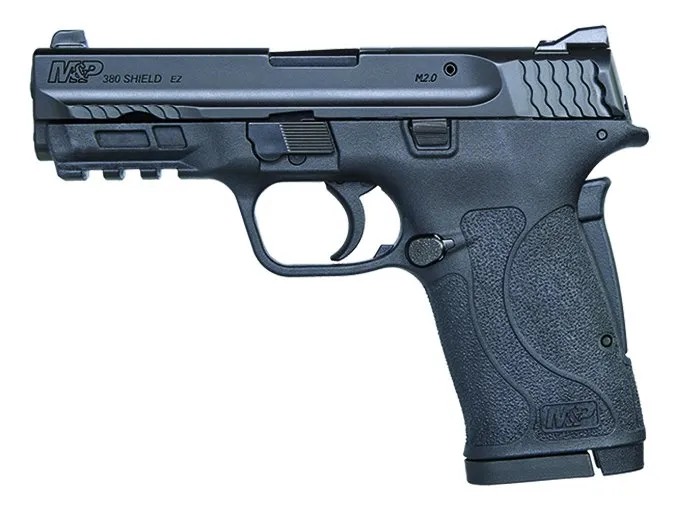
While we have serious reservations concerning the stopping potential of the 380 ACP round, there are some loads that are better than others, and we included these in the test program that follows. Regarding the handguns themselves, here we test three, two that are new variants by respected makers and a third that is a veteran name in the 380 ACP field, despite its being marketed for slim guys who often wear tuxedos.
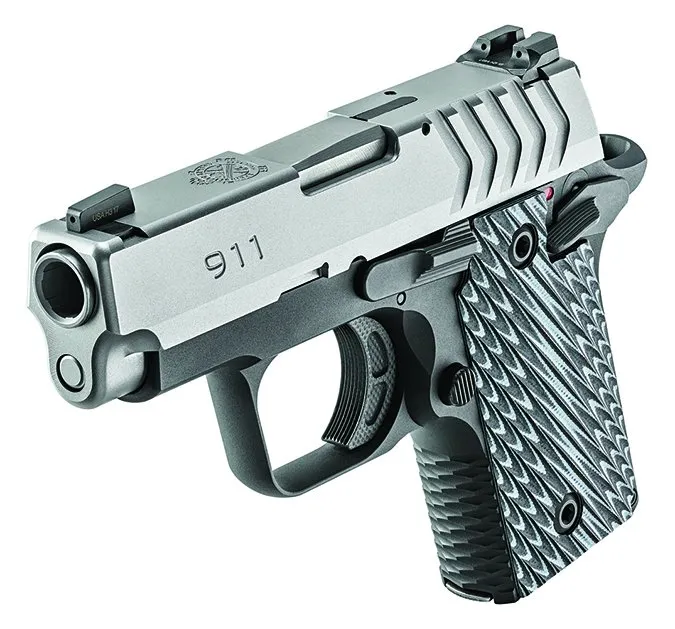
The first of these handguns is the Smith & Wesson M&P 380 Shield EZ 180023, $384, an important step toward offering a handgun that is well suited to those with lowered hand strength and dexterity. The new Shield isn’t a micro-compact pistol but is instead a nice-sized 380 that is all about easy shooting. The “EZ” part of the name refers to an easy cocking system Smith & Wesson claims will make the pistol better for those with limited hand strength to fire and use. If it works as advertised, Smith & Wesson will have provided a handgun that fills a real need. In initial handling, we found the Shield is easier to use than a revolver and most double-action-first-shot pistols because the other types may stress the trigger finger of elderly or female shooters. Likewise, double-action-only or striker-fired safe-action pistols may also present a problem with trigger strength with some shooters. For perspective, we also touched upon the Colt 1903, which, surprisingly, has much in common with the Smith & Wesson Military & Police 380 EZ.
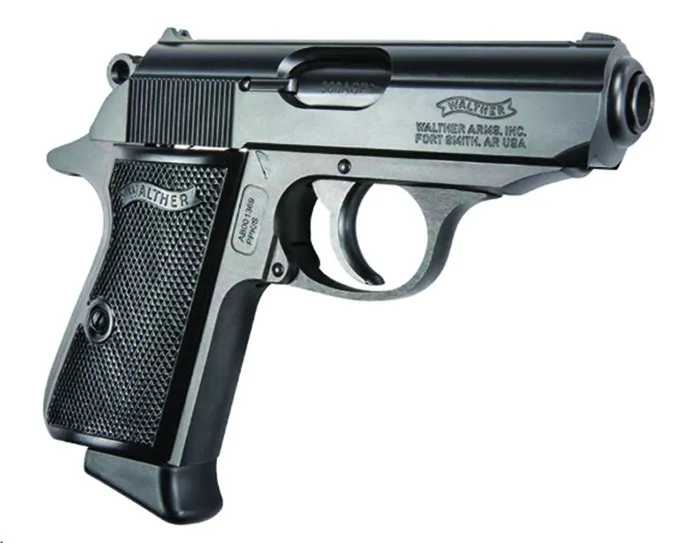
Next up is the Springfield Armory 911 Bi-Tone PG9109S, $516. The Springfield 911 (nine-one-one) is a small 380 ACP that is adorned from the factory with night sights and a set of custom-grade grips. The 911 name was chosen for those who may have to be their own first responder. If you get in a tussle, the thinking goes, police are minutes away if you call 9-1-1, while danger is only seconds away. So, carry the Springfield 911 and be ready at the ready. There are four different 911 models. The PG9109 has a black nitride slide and lists for $599 (see page 16). Two models come with Viridian Green Grip Lasers, the PG9109VG with a black nitride, $789; and the PG9109SVG with a brushed stainless-steel slide, also $789. Our test gun, the PG9109S, has a brushed stainless-steel slide and lists for $599.
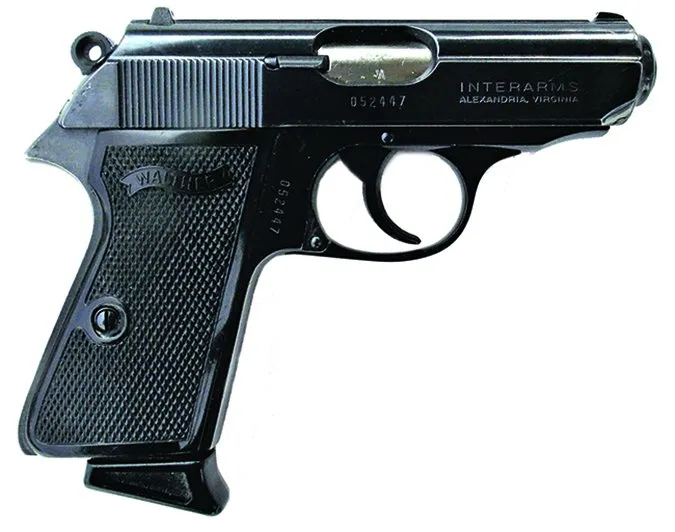
The Springfield 911 380 Auto is designed to be more comfortable to fire and use than other small pistols. Unfortunately, many buyers purchase a handgun based on size alone and do not consider how uncomfortable the handgun may be to fire. During prep handling, our shooters found the pistol is indeed easily concealed and offers good features.
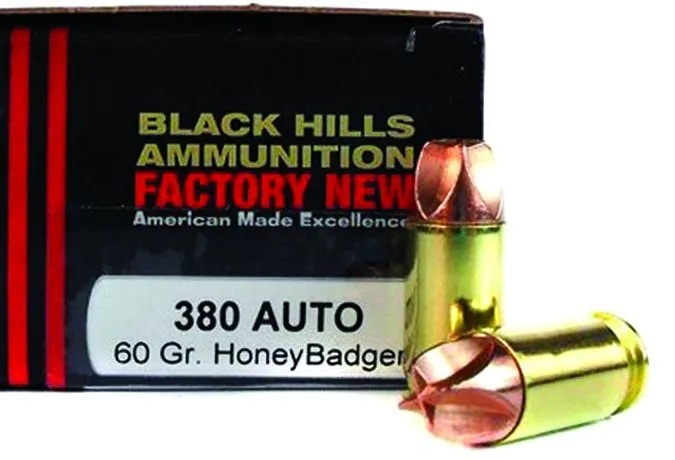
We matched the pistols against a classic Walther Arms PPK/S, $700, as a counterpoint. The last time we reviewed a Walther PPK/S was in the November 2002 issue. That variant was actually the stainless PPK/S-1 in 380 Auto, which at the time was made by Smith & Wesson under license from Walther. We suspect the S-1 designation meant Smith & Wesson’s first model. The PPK/S-1 test gun was easily distinguished from a European Walther by clear, workmanlike graphics that read “Smith & Wesson, Houlton, ME USA” underneath the Walther logo on the right-hand side of the slide. On the left side the words “Under License of” was added above the traditional Carl Walther marking. We thought the frame of the S-1 felt flatter and sharper and the machining appeared to be more austere than the German models, but to be sure of origin, the serial number of the pistol appeared plainly just behind the trigger guard, complete with PPK/S-1 designation.
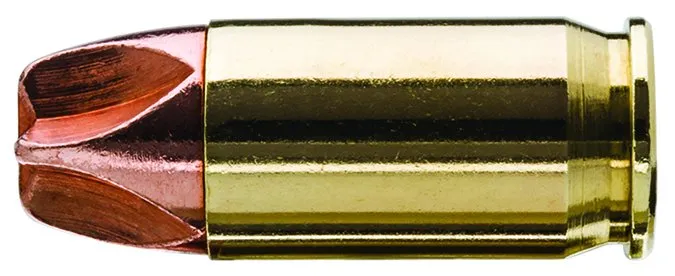
Our blued-steel test PPK/S-1 used all-steel fabrication and fed from a single-column magazine, meaning that its maximum capacity then and now was 7+1 rounds. Anyway, the Walther was not famous for its low weight, but instead for its thin profile. Also, the Walther doesn’t have a great reputation for reliability, and this test confirmed that. As we said then, it was easy to complain about the PPK/S’s inherent faults. As you will find out below, not much has changed in 16 years.
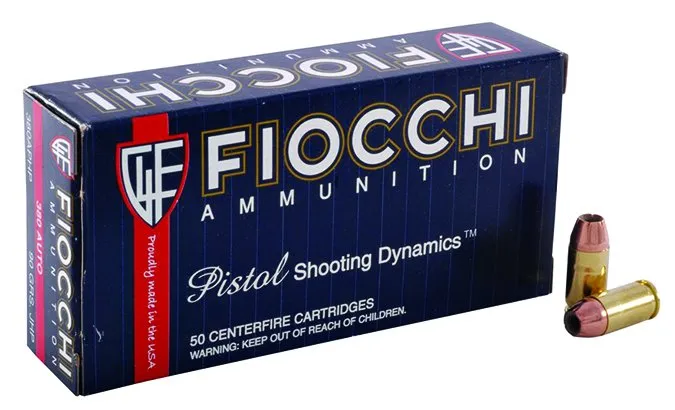
The result is a comprehensive test of popular handguns that ended up creating two distinct preferences among our raters: one preferring the Shield and the other the 911. We really liked the Smith & Wesson Military & Police 380 EZ. There is simply no fault with the handgun, save for its chambering, which we understood from the get-go. The Springfield 911 is the better concealed-carry handgun, we feel. The Shield, however, is the friendliest handgun we have tested in some time. It is accurate, reliable, and recoils little. It is easy to rack the slide and easy to load. The Springfield 911 is a good handgun as well, perhaps better suited to a more experienced shooter. The Shield is larger and a bit more difficult to conceal, but it is easier to carry than the handguns the raters have chosen for themselves, at this time in their carry careers. As one rater noted, “When I am much older, I think this might be my gun.”
Range Data
| 380 ACP Black Hills 60-gr. HoneyBadger | Smith & Wesson Shield EZ | Walther PPK/S | Springfield Armory 911 |
| Average velocity | 1180 fps | 1167 fps | 1155 fps |
| Muzzle energy | 185 ft.-lbs. | 181 ft.-lbs. | 177 ft.-lbs. |
| Smallest group | 2 in. | 2.4 in. | 1.9 in. |
| Average group | 2.4 in. | 3 in. | 2.7 in. |
| 380 ACP Fiocchi 90-gr. JHP 380APHP | |||
| Average velocity | 985 fps | 970 fps | 923 fps |
| Muzzle energy | 193 ft.-lbs. | 187 ft.-lbs. | 170 ft.-lbs. |
| Smallest group | 1.7 in. | 2.4 in. | 2 in. |
| Average group | 2.5 in. | 3.3 in. | 3 in. |
| 380 ACP Federal Premium HST 99-gr. JHP P380HST1S | |||
| Average velocity | 1024 fps | 990 fps | 970 fps |
| Muzzle energy | 230 ft.-lbs. | 215 ft.-lbs. | 206 ft.-lbs. |
| Smallest group | 1.7 in. | 2.6 in. | 2.7 in. |
| Average group | 2.2 in. | 3.5 in. | 3.4 in. |
| To collect accuracy data, we fired three five-shot groups with each load from a Brownells.com Bullshooter shooting rest and a solid benchrest. Distance 15 yards. We recorded velocities for each load with a Competition Electronics Pro Chrony 15 feet from the muzzle. Ammo sources: Fiocchi Shooting Dynamics 380 ACP 90-grain Jacketed Hollow Points 380APHP ($18/50 rounds from LuckyGunner.com), the Black Hills HoneyBadger 60-grain 380 ACP ($25.57/20 rounds from Brownells.com), and the Federal Premium 99-grain HST Jacketed Hollow Point P380HST1S ($19/20 rounds from LuckyGunner.com). | |||
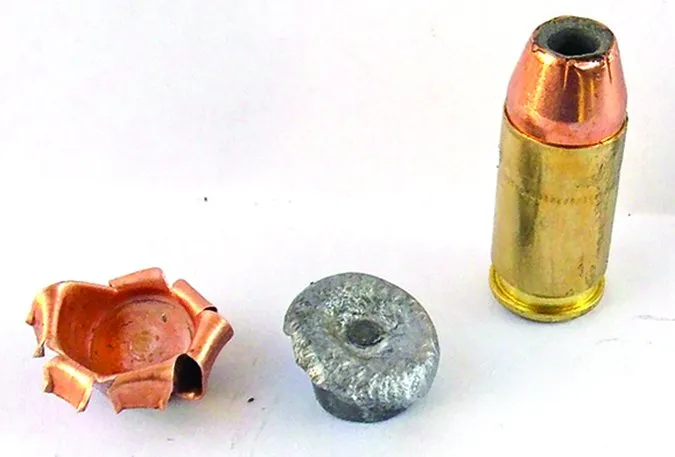
Test Ammunition
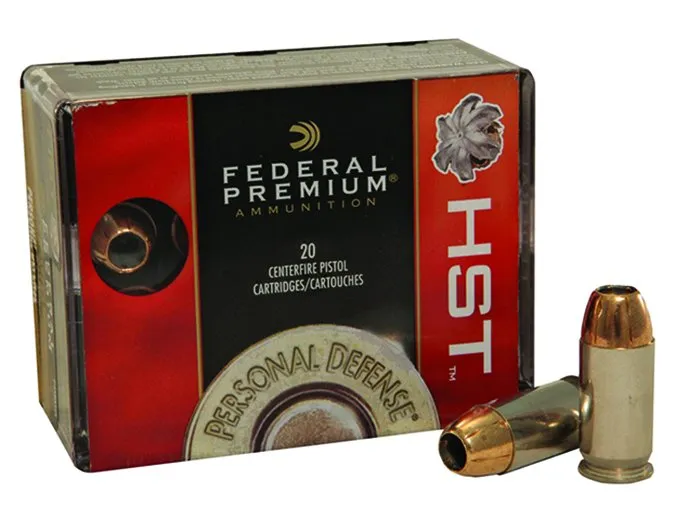
Firing for accuracy was also combined with a test of reliability with combat loads. We tested the pistols for accuracy at 15 yards. Loading the pistol for combat testing, we first used the Federal American Eagle 95-grain full-metal-jacket rounds ($12.49 per 50 from TargetSportsUSA.com). We used several loads that have proven to be good performers in the past. These included the Fiocchi 90-grain JHP ($18/50 rounds from LuckyGunner.com), the Black Hills 60-grain Honey Badger ($25.57/20 rounds from Brownells.com), and the Federal Premium 99-grain HST ($19/20 rounds from LuckyGunner.com).
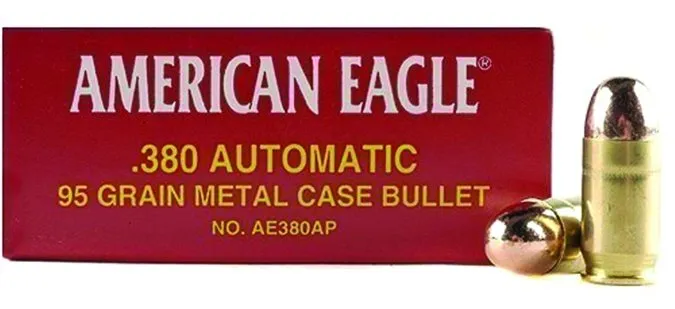
Recoil was stiffest with the Federal HST loading, as might be expected of a loading that reaches over 1,000 fps in this size handgun. Reliability could not be faulted with these loads. The Walther did not function with the heavy Federal load. Recoil was heavier in the Springfield by a noticeable margin. The best groups (1.7 inches) came with the Shield EZ shooting the Fiocchi 90-grain JHP and the Federal HST 99-grain loads.
Here are more details about how the guns performed.
Smith & Wesson M&P 380 Shield EZ 180023 380 ACP, $384
GUN TESTS GRADE: A
The Shield is EZ-ily among the most useful and attractive 380 ACP pistols we have tested. The Shield is a good choice for home defense for those who cannot handle a caliber larger than the 380 ACP. As a carry gun, it isn’t smaller than some 9mm Luger handguns, but it is much easier to fire well. The barrel length at 3.65 inches is the longest of the pistols tested and afforded the highest velocity and energy.
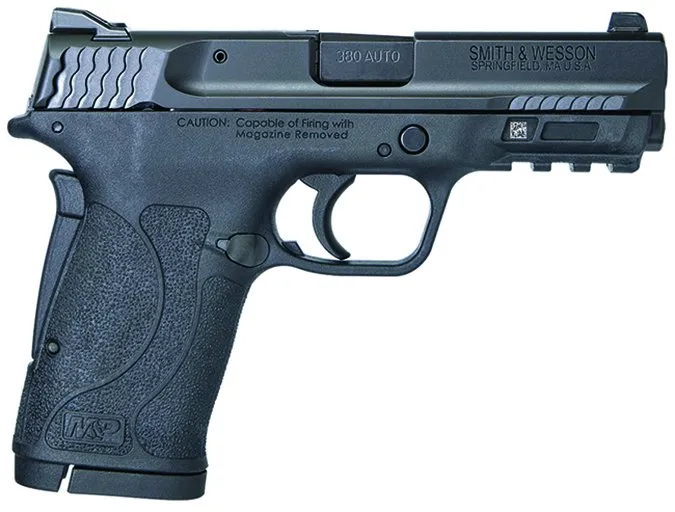
| ACTION | Single action; internal hammer fired |
| WEIGHT UNLOADED | 18.5 oz. |
| WEIGHT LOADED | 21 oz. |
| OVERALL LENGTH | 6.7 in. |
| BARREL | 3.675 in.; stainless steel, Armornite finish, tactile loaded-chamber indicator |
| OVERALL HEIGHT | 4.85 in. |
| MAGAZINES | (2) 8-rd. detachable boxes |
| FRONT STRAP HEIGHT | 2.15 in. |
| BACK STRAP HEIGHT | 2.95 in. |
| MAX WIDTH | 1 in. |
| GRIP THICKNESS (max) | 1 in. |
| GRIP CIRCUMFERENCE (max) | 5.1 in. |
| SLIDE | Armornite-finished stainless steel, 9.5 lbs. racking effort |
| FRAME | Black polymer, 3-slot rail; 18-degree grip angle |
| GRIP MATERIAL | Textured black polymer |
| TRIGGER PULL (SA) | 4.75 lbs., tactile and audible reset |
| TRIGGER SPAN (SA) | 2.6 in. |
| SAFETY | Grip |
| FRONT SIGHT | Fixed post, white dot |
| REAR SIGHT | Windage adjustable, white dot |
| WARRANTY | Limited lifetime |
| WEBSITE | Smith-Wesson.com |
| TELEPHONE | (800) 331-0852 |
| MADE IN | Springfield, MA |
This was the price for this gun at BudsGunShop.com. The Shield EZ pistol capitalizes on Smith & Wesson’s successful 9mm, 40- and 45-caliber defense pistols. The 380 ACP Shield, however, is only similar in appearance. The Smith & Wesson Shield 380 EZ is a single-action pistol with a fixed barrel.
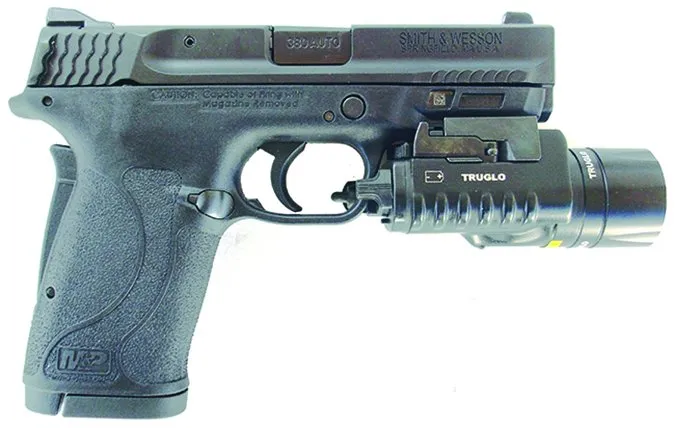
Racking the slide is also a concern. So, Smith & Wesson designed the Shield 380 EZ as a single-action type. While the single action makes sense, there are drawbacks to be addressed as well. This isn’t a striker-fired pistol, but it features an internal hammer. As such, when the slide is racked, the hammer is cocked. To make the pistol safe to carry, the Shield features a positive firing-pin block and also a grip safety that blocks the trigger. This grip safety is very easy to use. Simply grasp the pistol as you draw, and as you line up the target, completely depress the grip safety. The result is a nice single-action trigger press in a natural motion. Smith & Wesson offers also offers a version with a manual safety (No. 11663). The type with a manual safety was subject to a safety recall. We cannot comment on function of the No. 11663 model, but be certain to listen when a company makes a safety recall.
Fortunately, our pistol was not affected; it is only the handguns with a manual safety that were recalled. Pity, because our main rater stated that he would prefer a pistol with a frame-mounted safety because the action to put it on Fire is natural during the draw. Some prefer a manual safety, some do not. Smith & Wesson offers each. The current trend is toward pistols that are simple to use, point and shoot, but this line gives shooters the choice.
Let’s address how Smith & Wesson handled the issue of racking a slide with less effort than is usually needed. After all, no matter how easy to fire and use, a pistol at some point must be loaded and unloaded. The Shield EZ requires about 9 pounds of effort to rack the slide, which is light by any standard. The Springfield slide was slightly more difficult to rack at 9.7 pounds, but both were much easier to operate than the PPK/S at 12.5 pounds.
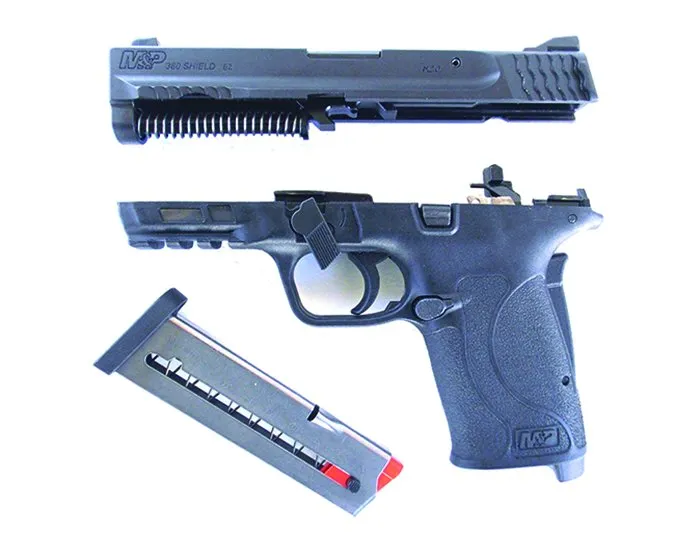
With the leverage and balance in length between the slide and handle, this pistol is quite easy to handle well. S&W also went to a lighter recoil spring and a lighter hammer spring. This is possible because the pistol is chambered in 380 ACP. There isn’t a lot of pressure required to contain the energy of the 380 ACP, which typically pushes 95-grain bullets at 950 fps. The recoil spring may be lighter, and the hammer spring may be light as well because the slide doesn’t need much energy to cock the hammer. A 9mm could not be this light and easy to manipulate.
We found the Smith & Wesson Shield 380 EZ to be a remarkably easy handgun to manipulate and use. There is more to it than that, however, because the pistol also features magazines that are easily loaded. The pistol is supplied with two magazines. A special extension on the all-steel magazines gives the shooter plenty of leverage to push down the magazine spring.
If we were picking a handgun for an accomplished shooter, we might choose another handgun, but the Smith & Wesson 380 Shield EZ is appealing to the shooter who needs a little help. Many people will have difficulty shooting and handling a full-size 9mm because the recoil spring must be rated to handle the heaviest loads. The recoil spring is compressed as the slide is racked. A weak spring may invite short cycles. So, the 380 ACP seems ideal for the person who has difficulty racking a slide. Just the same, we wanted to be certain that the Smith & Wesson Shield 380 EZ is reliable with all loads, so we used one of the heaviest 380 auto loads we know. The Federal 99-grain HST worked just fine in the Smith & Wesson, but not in the Walther. When firing the Shield with this heavy load, recoil was little different than with standard loads, which is something of a feat to accomplish. Some gun-shop salesmen cannot seem to understand that everyone isn’t the same. A shooter needs a handgun that will suit his or her physical needs and strengths. The pistol should be tailor made for them, and they should not have to step up and handle a handgun that is too difficult for them to manipulate. Otherwise, they might not be armed at all.
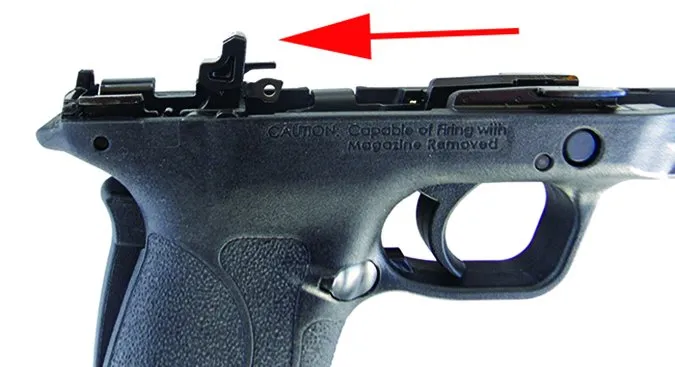
Smith & Wesson did not have to design this piece from scratch. The Smith & Wesson Military & Police Shield 380 EZ is based on the Smith & Wesson Military & Police 22-caliber pistol. The barrel and other key parts differ, but the outside dimensions are very similar. However, there are certain additions, including what Smith & Wesson calls the 2.0 improvements. The cocking serrations are well done and make racking the slide easier. The pistol features both forward and rear cocking serrations. The frame is nicely textured for fit and feel and gets high ratings on both adhesion and abrasion. The treatment doesn’t abrade the hand, but it provides good purchase. The frame is slanted at the backstrap at an 18-degree angle. This provides a good fit for almost any hand size. The human engineering of the pistol is excellent. When grasping the pistol to fire, our shooters expended no noticeable effort to close the grip safety and keep it closed. Yet as soon as you relax the grip, the pistol-grip safety returns to the Safe position. This is a good design.
The all-steel magazines feature an extension of the follower that is manipulated to move the follower to the bottom of the magazine and load the magazine. While all pistol magazines are more difficult to load toward the last of the cartridge load, the Shield 380 ACP magazines were never difficult to load, our shooters said.
When addressing the trigger, you will note that it doesn’t have the familiar trigger-safety lever inset into the trigger face as in Glock and Smith & Wesson Military & Police Shield fashion. The Shield EZ features a solid trigger for single-action fire. Other new designs, such as the Hudson H9, are single-action pistols without a safety, but they use the trigger-lever system in a modified manner. The Shield 380 does not need this trigger lever, thanks to the grip safety. When first measured at the beginning of the test and the pistol was straight from the box, the trigger broke at 5.0 pounds and felt clean. Take up was modest and the reset crisp. After firing more than 300 cartridges during the course, the trigger grooved in a bit lighter, as many single-action triggers will do, and it stayed at 4.8 pounds.
The pistol is similar in many ways to the Colt 1903 Pocket Hammerless. No, this isn’t a stretch of the imagination. The Colt 1903 features a single-action trigger with grip safety and a true slide-lock safety, which the Smith & Wesson doesn’t have, but each handgun features a hidden hammer. Both are well sized for the cartridge they fire, and each is very easy to fire well. Interestingly, John Moses Browning tried to convince FN that his 1910 Browning pocket pistol did not need the manual safety, only a grip safety. We fired a Colt 1903 side by side with the Shield and came away liking the Colt much better than the Walther and felt it was more comfortable than the Springfield as well. The Colt was chambered in 32 ACP, however, as the later 1908 model chambered the 380 ACP. They are identical otherwise. The Colt 1903 pistol fired 50 rounds of 32 ACP CCI Blazer without incident and it offered good combat accuracy. The Smith & Wesson Shield 380 EZ is more accurate, and even though it is chambered for the 380 ACP and weighs less than the Colt 32 ACP, the EZ was more comfortable to fire. Also, the Smith & Wesson sights are much better, and the pistol was slightly more accurate. As a side topic, this was very interesting to our shooters, who were surprised at how good the old Colt really was. But the Smith & Wesson Shield has every modern advantage over the Colt 1903 or 1908 in price, accuracy, and handling.
Loading the pistol for combat testing, we first used the Federal American Eagle 95-grain FMJs. The magazine was very easy to load, just as it was designed to be. We fired 100 rounds in each pistol at 5, 7, 10, and 15 yards. The raters added ammunition on their own time and dime as well because the pistol was so interesting. Hence, we had a higher-than-normal round count. In fairness, the Springfield got the same treatment. We also fired a magazine in each pistol of the Federal 99-grain HST in offhand fire. Because there were only two magazines, we took turns loading and never had any difficulty or stubbed a finger. We really like the grip angle, the white outline sights, and the trigger. A small handgun sometimes needs good sights more so than a full-size handgun because a shorter sight radius works against accuracy. We thought the Shield’s sights work well for combat shooting and for precise shooting. During the test, we racked the slide with only two fingers from time to time. The pistol works as designed. This is the only handgun tested that features a rail for a combat light, making it more useful for home defense.
Our Team Said: We like the Smith & Wesson Shield. We are generally not comfortable with the power level and wound ballistics of the 380 ACP; however, loads like the Black Hills Ammunition Honey Badger and the Federal HST make the cartridge much more attractive than the previous choice of ball ammunition or a JHP that underpenetrates. The pistol is a joy to fire and use. It is more than accurate enough for personal defense. In fact, while we are not concerned with field and trail use, one of the raters noted it is accurate enough for small game as well, and the centerfire cartridge is far more reliable than rimfire ammunition, making the Shield a better choice for personal defense than any 22 LR rimfire pistol. We like the concept of the Shield and the pistol itself and give it a solid A rating.
Springfield Armory 911 Bi-Tone PG9109S 380 ACP, $516
GUN TESTS GRADE: A
We liked the Springfield 911. Unlike the full-size 1911 it mimics, the Springfield is suited to carrying hammer down instead of cocked and locked, an important consideration for pocket carry. This is because the small size, light weight, and good handling make for a different geometry than full-size pistols.
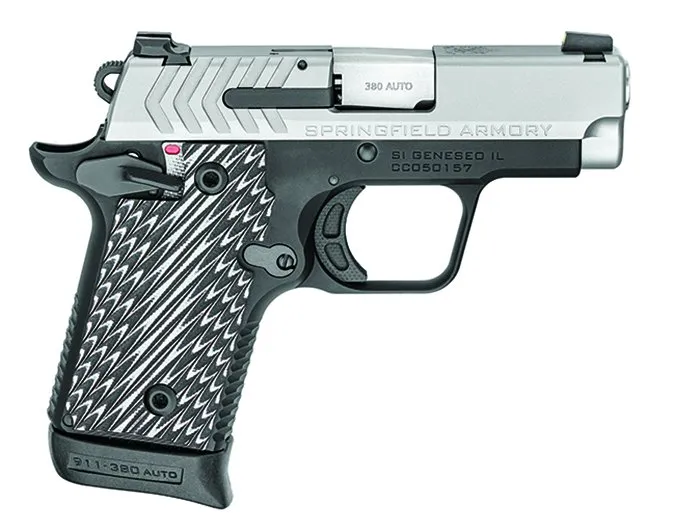
| ACTION | Semi-auto single action, internal hammer fired |
| WEIGHT UNLOADED | 12.5 oz. |
| WEIGHT LOADED | 15 oz. |
| OVERALL LENGTH | 5.5 in. |
| BARREL | 2.7 in.; 1:16 twist, 416R stainless steel |
| OVERALL HEIGHT | 3.9 in. |
| MAGAZINES | (1) 6-rd. flush, (1) 7-rd. extended stainless steel boxes |
| FRONT STRAP HEIGHT | 1.75 in., Octo-Grip texturing |
| BACK STRAP HEIGHT | 2.25 in., Octo-Grip texturing |
| MAX WIDTH | 1.1 in. |
| GRIP THICKNESS (max) | 0.85 in. |
| GRIP CIRCUMFERENCE (max) | 4.6 in. |
| SLIDE | Brushed stainless steel, full-length guide rod w/ flat-wire spring, loaded chamber indicator |
| FRAME | Anodized 7075 T6 aluminum |
| GRIP MATERIAL | G10 Thin Line |
| TRIGGER PULL (SA) | 5 lbs., Hogue G10 trigger shoe |
| TRIGGER SPAN (SA) | 2.5 in. |
| SAFETY | Extended ambidextrous frame-mounted lever |
| FRONT SIGHT | Ameriglo Pro-Glo tritium green/yellow |
| REAR SIGHT | Tritium green/white |
| WARRANTY | Limited lifetime |
| WEBSITE | Springfield-Armory.com |
| TELEPHONE | (309) 944-5631 |
| MADE IN | Geneseo, IL |
This was a recent price for the handgun listed at TombstoneTactical.com. Our seasoned raters discovered that with the heavy HST load, the little 911 pistol kicked. Recoil was greater than standard charge in the Fiocchi load. There is nothing wrong with these rounds, but a load like the HST that jolts the 99-grain bullet to 950 fps from the 2.6-inch Springfield barrel is to be respected.
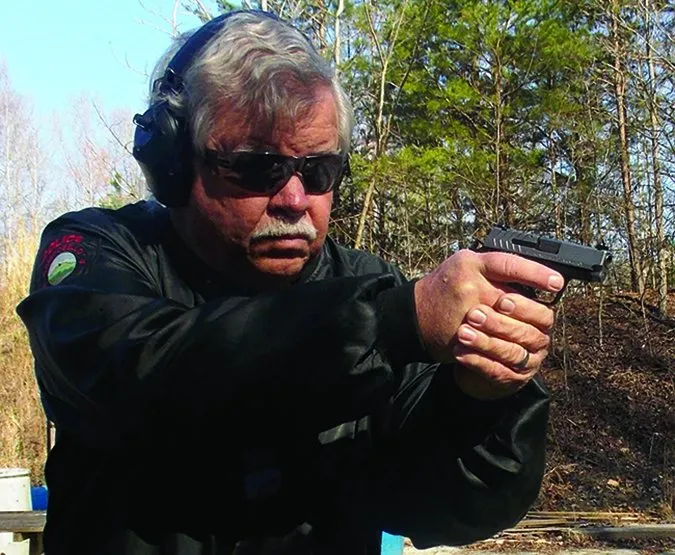
Elsewhere, embryonic sights, heavy triggers, and short grips make for terrible results on the range. The 911 is a counterpoint to pocket handguns so fitted. The 911 pistol combines ergonomic design with small size and weight. The pistol is smaller than the Shield and easier to conceal, but it isn’t as easy to use well.
The Springfield is only 4 inches tall, and the length is just 5.5 inches, so this is a concealable handgun. Weight empty is 12.5 ounces. This isn’t a vest-pocket pistol, but it is a pocket pistol that will disappear into crew pockets and hide easily in others. The pistol features an elongated backstrap tang commonly referred to as a beavertail. This is to prevent the all-too-common problem of the slide biting into the web of the hand. Sometimes called hammer bite, the slide or sharp edges of the tang are more often to blame for these cuts. Springfield adds a custom touch with a front strap that is finished in an Octo-Grip pattern to match the Hogue mainspring housing. The grips are manufactured for Springfield by Hogue and provide the same pattern. Adhesion and abrasion are excellent. When measuring the grips and the safety, we found the pistol is just short of an inch wide at the widest point. The slide, however, is only 0.81 inch wide. This is a truly compact pistol.
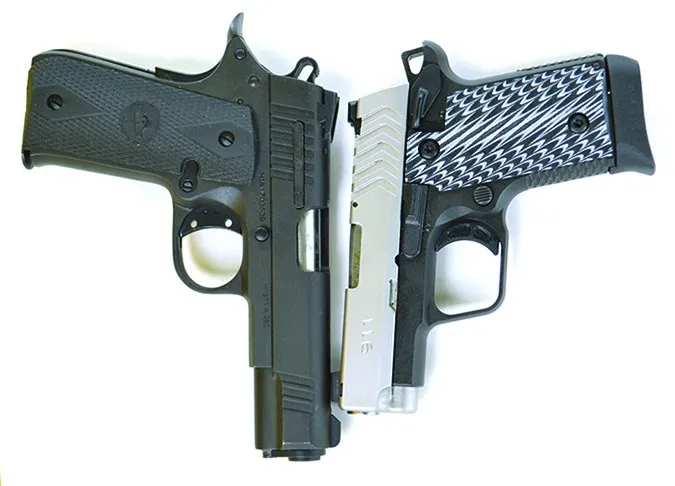
At this juncture, we should point out that the Springfield 911 380 isn’t a downsized 1911, save in appearance. It is a single-action handgun with a thumb safety, but it isn’t a true 1911 as the Baby Rock 1911 380 is, as an example. There is no grip safety. As for the safety, it isn’t a slide-lock safety. The safety is applied and does not stop the slide from moving. While we may prefer a slide-lock safety that locks the slide in place when we are using a tightly fitted holster, the ability to load the pistol while it is on Safe is an advantage of the Springfield system. The magazine release, location of the safety, slide stop, and general appearance are 1911-like. Another significant departure from the 1911 design is in the 911’s lock up, which does away with both the barrel bushing and the swinging link of the full-size 1911. The pistol unlocks and locks by a cut out in the lower barrel.
As for fit and finish, the total verdict was that the pistol is faultless in execution. The little 911 rivals or equals top-end Springfield, Kimber, or Colt 1911 handguns for fit and finish. The controls are positive and work as designed. The trigger is good to excellent, breaking at a crisp 4.9 pounds with little take up and no creep. Reset is good and sharp. Pulling a heavy trigger against a lightweight handgun is a chore, and the Springfield trigger is an aid in controlling this light handgun.
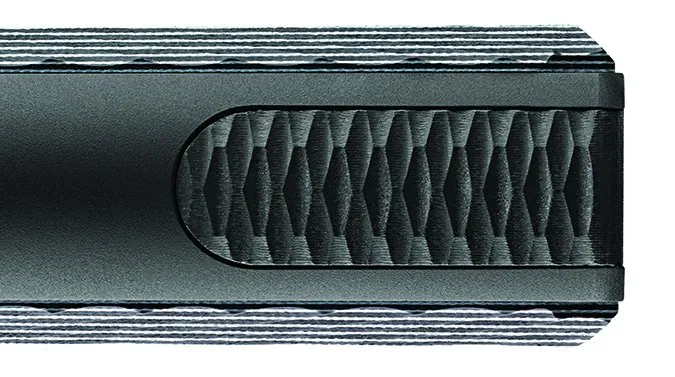
There are many small pistols with very poor sights. While the Walther PPK/S 380 has relatively small sights, the Colt 1903 we examined was even smaller, and some designed for pocket carry have nothing more than a nub on top of the slide. We feel that this is a mistake. A small handgun has a short sight radius already, so poor sights limit accuracy even further. Shot placement is everything with every handgun caliber, and particularly so with a lower-power round. The Springfield features some of the best sights we have examined on a pocket pistol and were easily the best of the three handguns tested here. These sights are excellent for all purposes. The Ameriglo Pro-Glo front sight features a brilliant green tritium insert surrounded by a yellow circle. The yellow component is luminescent and useful in all lighting conditions. The front sight gets your attention quickly and allows very fast and accurate shooting at 3 to 7 yards using only the front sight. The rear sight features an open U notch commonly referred to as the “old man’s sight,” and the name fits even for those who are quite young and wish to use this sight.
The pistol isn’t difficult to disassemble, but it isn’t as easily broken down as the Shield. The Smith & Wesson Shield 380 EZ is unloaded and the slide locked to the rear to disassemble, same as the 911, but the Shield is then field stripped by rotating a lever and running the slide forward. With the 911, the pistol is unloaded (never forget that), and then the shooter retracts the slide enough for the cut out on the slide to allow the slide lock to be pressed from left to right to remove. The slide is then run forward. The recoil-spring guide is removed, and the barrel is removed. When the pistol is reassembled, the ejector must be pressed downward to reassemble the pistol. The Shield is easier to field strip and put back together.
The Walther PPK features a hinged trigger guard that is pressed downward to release the slide. With the trigger guard popped out of place, the slide is pulled to the rear and off the fixed barrel for field stripping. The recoil spring is wrapped around the barrel rather than under the barrel with the Walther design. The Walther is reassembled by pressing the slide back over the barrel and then snapping the trigger guard in place. We rated the Shield to be the easiest to maintain and field-strip and lube. The Walther and the 911 are different, but each is old school and require about the same time and effort to be field-stripped.
Firing the pistol for combat accuracy, we found the Springfield 911 exhibited the most recoil of any of the pistols tested, due to its light weight, but it wasn’t uncomfortable to fire. The grip is well shaped to fit most hand sizes, and the trigger action is smooth, the sights are excellent, and results on target satisfied us. We also fired a full magazine off hand using the Federal 99-grain HST loading, learning that recoil was noticeably heavier than the other loads. However, unlike the Walther, function was flawless. The recoil isn’t harsh like firing a 45 ACP +P; the pistol simply kicks more. There were no malfunctions of any type firing the Springfield 911. Accuracy off the bench rest firing position was acceptable, but not as nice as the groups fired with the Smith & Wesson Military & Police 380 EZ, which delivered groups of 2.2 inches to 2.5 inches at 15 yards — good groups for such a light handgun and in line with the results posted by the much heavier Walther PPK/S.
A big plus, in our opinion, is the carrying case provided with the Springfield 911. The cardboard box the pistol is delivered in features a carrying handle, and the box is more robust than most, suitable for storage. Inside is a carrying pouch for the pistol and its lock and spare magazine. Inside the carrying pouch is a pocket holster secured to the carrying pouch. This holster works as well as most; we liked it for carrying the 911 in a jacket pocket or trousers.
The user must make the choice of carrying the piece with either a 7-round magazine with a finger extension or a flush-fit 6-round magazine. The 7-round magazine is easier to get a good grasp on. There was a slight difference in the firing results, with the extended magazine offering greater comfort and leverage in firing. The rule we came up with is, that if the pistol is carried in the pocket, the flush-fit magazine is the better choice. If carried in a holster, the finger extension magazine isn’t a problem. When the magazine is carried in the back pocket or jacket pocket, for a fast reload the finger-extension magazine is the easiest to quickly grasp.
Our Team Said: We liked the Springfield 911. It is a reliable handgun, which is the most important consideration. It is useful in personal-defense scenarios, and it exhibited enough control and accuracy that we would be comfortable carrying it. We were most impressed by the sights. While more expensive than the Smith & Wesson Shield, it is smaller and more suited to pocket carry.
Walther PPK/S 4796006 380 ACP, $700
GUN TESTS GRADE: C
The Walther features excellent machine work. The action was heavy and made getting good hits very difficult in the double-action mode. The pistol was not reliable with a modern load designed to maximize the 380 ACP cartridge. We would not buy the Walther PPK/S.
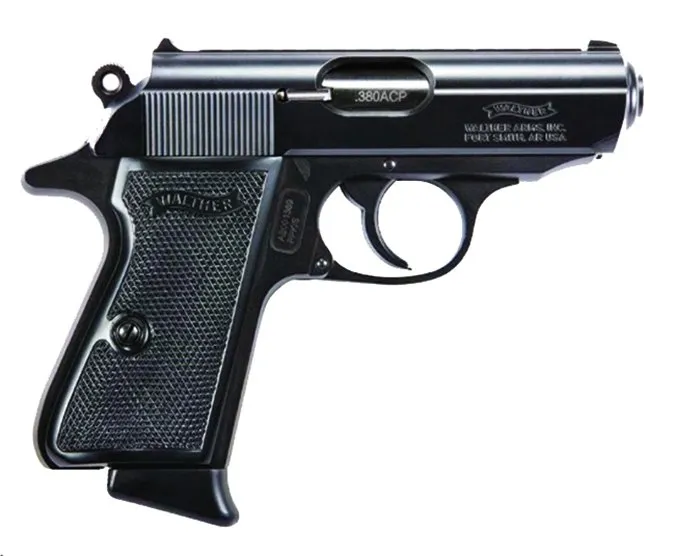
| ACTION | Semi-auto single/double action; external hammer fired |
| WEIGHT UNLOADED | 23.6 oz. |
| WEIGHT LOADED | 26.2 oz. |
| OVERALL LENGTH | 6.3 in. |
| BARREL | 3.3 in.; blued steel |
| OVERALL HEIGHT | 4.75 in. |
| MAGAZINES | (1) 7-rd. extended, blued-steel box |
| FRONT STRAP HEIGHT | 2.2 in. |
| BACK STRAP HEIGHT | 2.4 in. |
| MAX WIDTH | 1.1 in. |
| GRIP THICKNESS (max) | 1.1 in. |
| GRIP CIRCUMFERENCE (max) | 4.9 in. |
| SLIDE | Blued steel; rear serrations; wavy top-strap serrations |
| FRAME | Blued steel |
| GRIP MATERIAL | Black plastic, checkered |
| TRIGGER PULL (SA) | 6 lbs. |
| TRIGGER PULL (DA) | 14 lbs. |
| TRIGGER SPAN (SA) | 2.9 in. |
| TRIGGER SPAN (DA) | 3.3 in. |
| SAFETY | Left-side lever, firing pin block |
| FRONT SIGHT | Fixed blade |
| REAR SIGHT | Fixed notch |
| WARRANTY | Limited lifetime (new); none (used) |
| WEBSITE | WaltherArms.com |
| TELEPHONE | (479) 242-8500 |
| MADE IN | Fort Smith, AR (new); Germany (used) |
This was a recent price listed on Cabelas.com. Cabela’s notes that delivery on the PPK/S to your local FFL takes five to eight business days. We also fired a used Walther PPK/S, $400, to get a better price match up to the others. The Walther’s used price was in the range of handguns of the type in the condition exhibited, solid mechanically but with finish wear. The finish was not perfect, but it was very good save for a mar across the slide. The pistol functioned well as far as the action goes, and it was purchased with a single magazine. Most listing for new guns usually come with a single magazine as well. Additional magazines are available on the WaltherArms.com website.
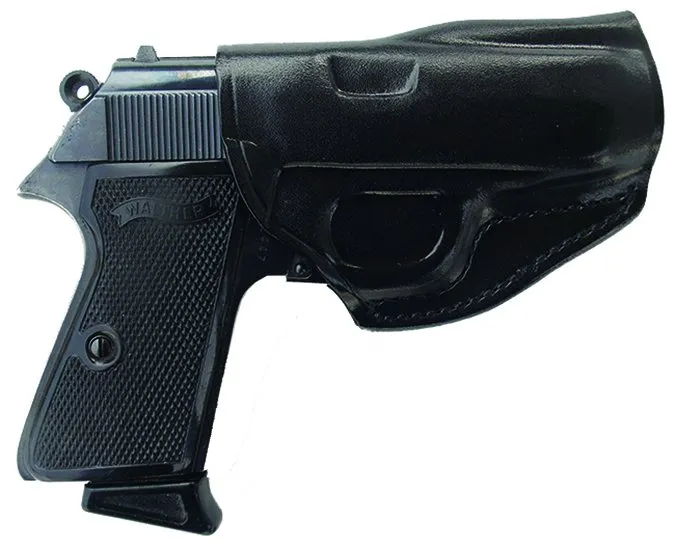
The pistol is the PPK/S version, or the short-slide PPK with the long PP-type grip. The single magazine featured a finger rest. We noted the rear sight was pressed to the left, and found the pistol was sighted in properly when fired. The Walther isn’t difficult to rack to load, but it was more difficult than the Shield or the 911 handguns and might give elderly shooters a problem. The pistol has attractive features, such as a serrated top rib between the sights. The markings are nicely engraved.
The PPK/S is a double-action-first-shot pistol. A long press of the trigger both cocks and drops the hammer. The slide then cocks the hammer for subsequent single-action shots. A slide-mounted decocker safely lowers the hammer from the cocked position. This lever also acts as a safety. When manipulating the safety, it wasn’t difficult to reach the lever to move it to the Safe position, and it wasn’t difficult to use the decocker to lower the hammer. The grips gave adequate purchase. Earlier PPK pistols had a reputation for the slide cutting into the palm of the hand. We did not experience this. The double-action first shot of the pistol was heavy at 16 pounds, normal for the Walther PPK series. The single-action press was crisp enough at 6 pounds. The sights are smaller than the other pistols, which is a drawback. Walther lists an XS replacement sight set on its website, which would likely improve this pistol’s overall grade a full notch if installed.
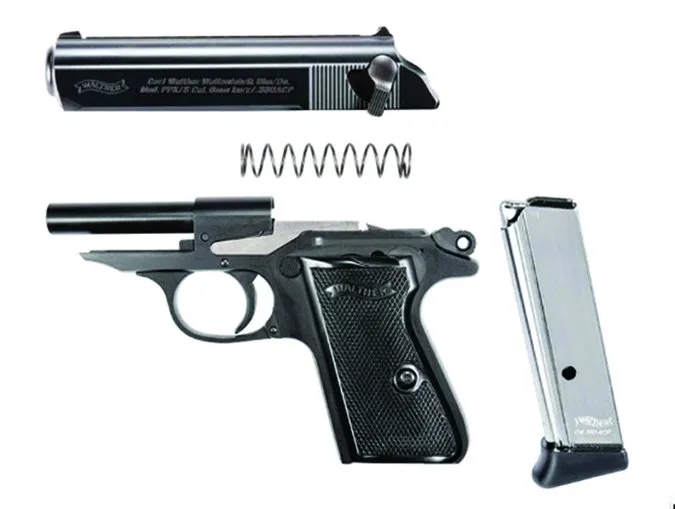
At the range, our shooters lubricated the Walther and loaded a magazine with the American Eagle FMJs. We immediately noticed it was very difficult to get good hits with it in double action. The heavy double-action-first-shot trigger and the pistol’s high bore axis made for poor results. At 7 yards, hits were difficult to get but possible, but at 10 yards the PPK/S was very difficult to shoot accurately. In single action, the results were different; we got good hits out to 15 yards. Still, the results were not as good as the Shield by a wide margin. The pistol did not malfunction with the Eagles during this combat shooting period.
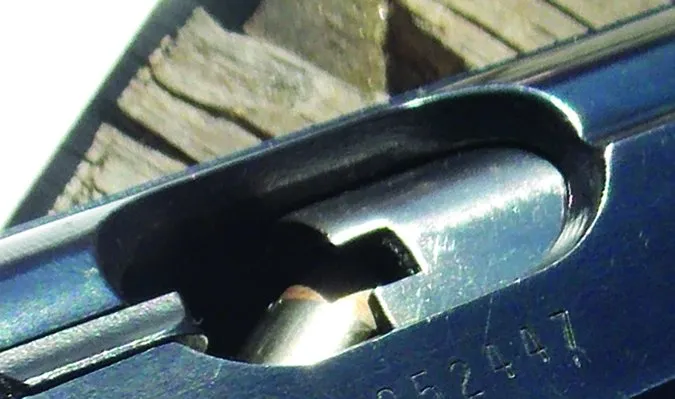
Firing from the bench, we used the same loads as the Shield. Results with the Fiocchi 90-grain JHP were best, with the high velocity Black Hills Ammunition also giving good results. The pistol refused to function with the powerful Federal HST loading. (It had also failed with this load during the single magazine attempted during the combat course.) Short cycles were common, and no more than three rounds were fired without a malfunction. The slide’s momentum was too much for the Walther.
Our Team Said: This handgun isn’t as easy to use well, nor is it as accurate or reliable as the other pistols tested. In our view, it is more of a collector’s item than a personal-defense handgun, at least when compared to the other pistols in this test. We rated the pistol down a full grade on failures to function and another grade on combat accuracy. Even had the pistol been reliable with the HST loading, accuracy performance was far less than the level exhibited by the Smith & Wesson Shield, and even the lightweight Springfield 911 performed better. At $700 new and $400 used, we just can’t see a reason to buy a PPK/S.
Written and photographed by Gun Tests Staff, using evaluations from Gun Tests team testers.



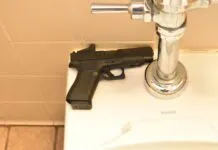


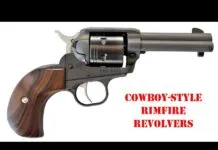
















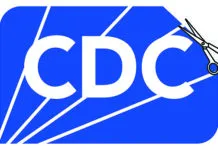






I am an old man (71) with arthritic hands and bad shoulders – the S&W 380 EZ is a blessing. All my life I have owned (and still own) M1911’s in 45ACP and 9mm, but the last few years racking the slide on the 1911’s has been a struggle. The 380 Auto may be an anemic cartridge, but since I am an anemic old man it suits me well. The 380 EZ is so easy to operate I should be able to use it right up to the day before they plant me. Thanks Smith and Wesson.
P.S. My 380 EZ has a manual safety, which is located and functions just like an M1911 safety. I have fired hundreds of thousands of rounds through pistols in my lifetime, yet I still insist on a manual safety on my SA pistols. Perhaps I am simply an incompetent pistol handler, but to me a pistol with a safety that is released by pulling the trigger is a hazard. My neighbor is a Glock fan. It takes five pounds of trigger pressure to fire his Glock. All my M1911’s break between 4 and 5 pounds. To me that says that a Glock is no safer than an M1911 in Condition 0 – and nobody I know would carry an M1911 in Condition 0. In a perfect world with perfect trigger discipline a Glock and other similar pistols are a perfect choice. In the world I live in things sometimes go wrong, a manual safety just adds one more level of security.
Interesting article. I have a PPK/S and find it extremely accurate in single action and have never had a jam, maybe i’m lucky or maybe the reviews were having a bad day. I find the extra weight of the PPK/S a plus, as it limits felt recoil and results in faster target acquisition.
I have been a subscriber for some time but sometimes i wonder about the reviews.